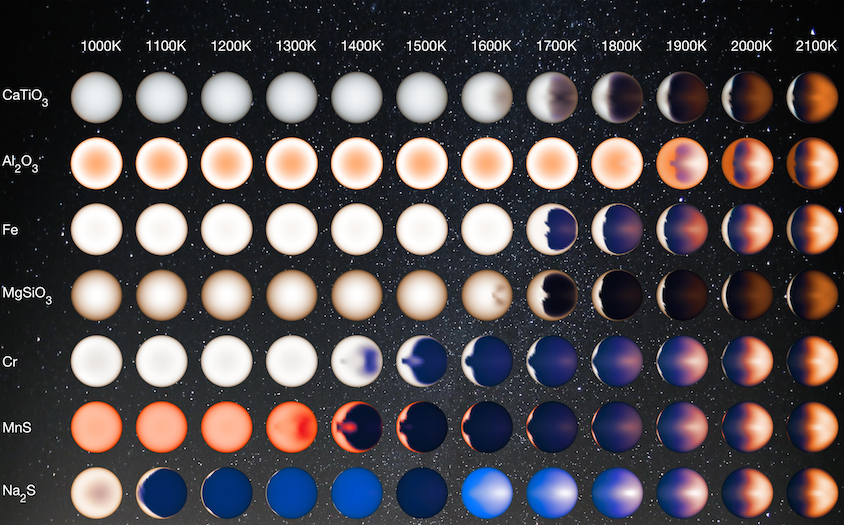story by Helen Hill


What a human eye would see if he were looking at one of theses planets. The colors are a combination of cloud reflection, gaseous rayleigh scattering, absorption by sodium gas and thermal emission of the planet – image credit: V. Parmentier
Hot Jupiters are gas giant planets orbiting very close to their star. They are tidally locked, with a permanent dayside and a permanent nightside. In recently published work in the Astrophysical Journal, Vivien Parmentier, a NASA Sagan postdoctoral fellow in the Lunar and Planetary Laboratory at the University of Arizona, in collaboration with long time MITgcm planetary atmosphere modelers Adam Showman, Jonathan Fortney and others, has been using the MITgcm to study the likely distribution of clouds on these planets.
Clouds result from the condensation of chemicals with different chemical species condensing at different temperatures. The cooler parts of the planet, such as the nightside is predisposed to have more clouds. For a given cloud type, cooler planets should be entirely covered by clouds. For more strongly irradiated planets, the dayside becomes too hot for clouds to form, leading to a clear dayside. In between, partially cloudy daysides are expected.

Authors best guess of how cloud composition varies with the temperature of the planet – Image credit: V. Parmentier
Using the thermal structure calculated using the MITgcm, Parmentier was able to determine at which longitude clouds are more likely to form. The asymmetric thermal structure (mainly an eastward shift of the hottest point of the planet) that originates from the model, and which is backed up by much observational evidence, leads to an inhomogeneous cloud structure. Given a calculated temperature map, different cloud species produce a different cloud distribution because they have different condensation temperatures.

Vivien Parmentier is a Postdoctoral Sagan Fellow at the Lunar & Planetary Laboratory, University of Arizona, in Tucson. He moved to Arizona from Santa-Cruz in 2015. He has been using the MITgcm for the past 5 years looking at hot Jupiters. He says when he is not modeling exoplanets he likes biking around the world but that for the past couple of years he has been on “another kind of adventure: Taking care of his two <3 years old daughters.”
Using MITgcm to generate a range of hot jupiter atmospheres with different equilibrium temperatures, the team were able to study the distribution of cloud for a range of different chemical species. “For a given cloud species the change from a fully cloudy to a cloudless day-side happens at a very specific equilibrium temperature. The equilibrium temperature at which we see a partially cloudy planet therefore provides a strong metric for cloud composition.” Parmentier explains.
The Kepler spacecraft can observe the reflected light from hot Jupiter atmospheres, leading to constraints on the longitudinal variations of the cloud coverage. By comparing MITgcm models with Kepler data, Parmentier was able to determine the more likely composition for the cloud coverage. Among his results he showed that not all planets posses the same clouds. Silicate clouds (MgSiO3) can form in high temperature planets but must disappear in cooler planets, where Manganese sulfide clouds (MnS) are more likely to form. A very similar cloud transition has been seen in brown dwarfs atmospheres.
To find out more about this work contact Vivien
This Month’s Featured Publication
- Vivien Parmentier, Jonathan J. Fortney, Adam P. Showman, Caroline Morley, and Mark S. Marley (2016), Transitions in the Cloud Composition of Hot Jupiters, The Astrophysical Journal, Volume 828, Number 1, doi: 10.3847/0004-637X/828/1/22
Parmentier’s first publication using the MITgcm was the 2013 paper in Astronomy and Astrophysics 3D mixing in hot Jupiters atmospheres. I. Application to the day/night cold trap in HD 209458b. In it he included tracers in a hot Jupiter model to determine how the large-scale circulation can mix up the clouds. The surprising result was that despite being radiative (and not convective), hot Jupiter atmospheres are very well mixed and cloud particles can easily be lifted to high altitudes.
Showman et al. (2009), Atmospheric Circulation of Hot Jupiters: Coupled Radiative-Dynamical General Circulation Model Simulations of HD 189733b and HD 209458b was the paper that orginally adapted MITgcm to model hot Jupiters by adding the appropriate radiative transfer component.
Other New Publications this Month
Ryan P. Abernathey, Ivana Cerovecki, Paul R. Holland, Emily Newsom, Matt Mazloff & Lynne D. Talley (2016), Water-mass transformation by sea ice in the upper branch of the Southern Ocean overturning, Nature Geoscience 9, 596–601 (2016) doi: 10.1038/ngeo2749
Congfang Ai and Weiye Ding (2016), A 3D unstructured non-hydrostatic ocean model for internal waves, Ocean Dynamics, online 25 August 2016, doi: 10.1007/s10236-016-0980-9
Steve Buchan and Kenji Shimizu (2016), High Frequency Internal Solitary Waves – Measurement and Modelling, 14th International Workshop on Wave Hindcasting and Forecasting & 5th Coastal Hazard Symposium, November 8-13, 2015, Key West, Florida,
Di Dong, Xiaofeng Yang, Xiaofeng Li, Ziwei Li (2016), SAR Observation of Eddy-Induced Mode-2 Internal Solitary Waves in the South China Sea, IEEE Transactions on Geoscience and Remote Sensing, Volume: PP, Issue: 99, pp 1-13, doi: 10.1109/TGRS.2016.2587752
Timothy F. Duda, Weifeng Gordon Zhang, Karl R. Helfrich, Ying-Tsong Lin and Arthur E. Newhall (2016), Modeling Internal Solitary Wave Development at the Head of a Submarine Canyon, VIIIth Int. Symp. on Stratified Flows, San Diego, USA, Aug. 29 – Sept. 1, 2016,
R.A. Ibrayev, G.S. Dyakonov (2016), Modeling of ocean dynamics with large variations in sea level, Atmos. Ocean. Phys. (2016) 52: 455. doi: 10.1134/S000143381604006X
Daniel C. Jones, Andrew J. S. Meijers, Emily Shuckburgh, Jean-Baptiste Sallée, Peter Haynes, Ewa K. McAufield, Matthew R. Mazloff (2016), How does Subantarctic Mode Water ventilate the Southern Hemisphere subtropics? Journal of Geophysical Research Oceans, doi: 10.1002/2016JC011680
Samuel M. Kelly, Pierre F.J. Lermusiaux (2016), Internal-tide interactions with the Gulf Stream and Middle Atlantic Bight shelfbreak front, Journal of Geophysical Research Oceans, published 23 August 2016, doi: 10.1002/2016JC011639
Michael A. Martin (2016), Influence of momentum excess on the pattern and dynamics of intermediate-range stratified wakes, Masters Thesis, Monterey, California: Naval Postgraduate School, http://hdl.handle.net/10945/49338
Valeria Montalto, Brian Helmuth, Paolo M. Ruti, Alessandro Dell’Aquila, Alessandro Rinaldi, Gianluca Sarà (2016), A mechanistic approach reveals non linear effects of climate warming on mussels throughout the Mediterranean sea, Climatic Change (2016), doi: 10.1007/s10584-016-1780-4
R.C. Musgrave and T. Peacock (2016), The momentum balance of steady flow past an island, VIIIth Int. Symp. on Stratified Flows, San Diego, USA, Aug. 29 – Sept. 1, 2016, https://joss.ucar.edu/sites/default/files/meetings/2016/issf/papers/musgrave-ruth-article.pdf
Timour Radko and Erick Edwards (2016), Diapycnal Velocity in the Double-Diffusive Thermocline, Fluids 2016, 1(3), 25; doi: 10.3390/fluids1030025
Kenji Shimizu and Keisuke Nakayama (2016), Oblique nonlinear interaction of internal solitary-like waves in the Andaman Sea, VIIIth Int. Symp. on Stratified Flows, San Diego, USA, Aug. 29 – Sept. 1, 2016, https://joss.ucar.edu/sites/default/files/meetings/2016/issf/papers/kenji-shimizu-article.pdf
Kevin B. Stevenson et al. (2016), Spitzer Phase Curve Constraints for WASP-43b at 3.6 and 4.5 μm, arXiv: 1608:00056v1 (30 July 2016)
Georgi G. Sutyrin and Timour Radko (2016), Stabilization of Isolated Vortices in a Rotating Stratified Fluid, Fluids 2016, 1(3), 26; doi: 10.3390/fluids1030026
P.R. Thompson, C.G. Piecuch, M.A. Merrifield, J. P. McCreary, E. Firing (2016), Forcing of recent decadal variability in the Equatorial and North Indian Ocean, Journal of Geophysical Research Oceans, online August 24, 2016, doi: 10.1002/2016JC012132
Wang, T., Le Maître, O.P., Hoteit, I. et al. (2016), Path planning in uncertain flow fields using ensemble method, Ocean Dynamics, doi: 10.1007/s10236-016-0979-2
Young Ro Yi, Sonya Legg and Robert Nazarian (2016), A process study of tidal mixing over rough topography, VIIIth Int. Symp. on Stratified Flows, San Diego, USA, Aug. 29 – Sept. 1, 2016, https://joss.ucar.edu/sites/default/files/meetings/2016/issf/papers/yi-young-article_0.pdf
G. Zodiatis et al. (2016), The Mediterranean Decision Support System for Marine Safety dedicated to oil slicks predictions, Deep Sea Research Part II: Topical Studies in Oceanography, doi: 10.1016/j.dsr2.2016.07.014
Do you have news about research using MITgcm? We are looking for contributions to these pages. If you have an interesting MITgcm project (ocean, atmosphere, sea-ice, physics, biology or otherwise) that you want to tell people about, get in touch. To make a post, contact Helen
